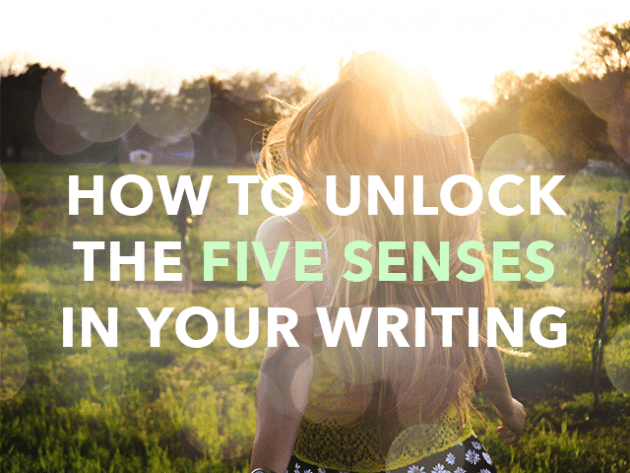As writers, we are especially aware of the five senses, especially when we focus on setting or descriptive writing. The five senses should work together to transport our readers into our character's world and to bring the story to life.
However, if you're like me, you might need to brush up on how to use the five senses in your writing to the fullest potential.

I didn't used to give the five senses much credit when it came to my writing. But the truth is, the five senses have a power to connect with our readers in a deep way.
How to Write Using All 5 Senses
It's all well and good to tell you you should use the five senses in your writing. But how? Here are some ways you can draw on each sense to immerse your readers in your story:
Write With Sight
When I was writing the first draft of my book, I met regularly with a writer's group (which is essential), and one of the pieces of feedback I received most was “show, don't tell.”
Don't simply tell your reader how you feel or what is going on, my writing group told me. Show them.
I began to experiment, and I soon discovered there is more to writing visual descriptions than “green trees” and “blue skies.”
Here's an exercise: Ask yourself, “What am I seeing?” and follow with, “Why does it matter here?”
You might start with a man walking by, but I challenge you to look further.
Maybe the man has tattoos covering his arms—can you see any colors or shapes? Describe them. Pay attention to the way he walks. Does he stare at the ground or straight ahead?
What do you really see? What do you not see? What does it mean?
When you focus on sight in writing, you're giving readers the details they need to picture the character and scene.
Write With Taste
Describing taste can be a fun way to keep your reader intrigued by the details. So often we forget to describe the way something might taste or what that taste means. We can write straightforward description of how a character is experiencing a taste, or consider other ways to convey it.
My favorite way to describe what something tastes like is with a metaphor. This might be awful, but my favorite comedian, Tim Hawkins, compares the flavor and taste of a Krispy Kreme donut to “eating a baby angel.” How true is that, though?
My roommate describes her hot tomato soup as “coming in from a blizzard, kicking your boots off, and sitting in front of the fire.”
The metaphors we use have the power to transport our readers to places that evoke memories and emotion from their own lives, allowing a deeper connection to be made.
The next time you sit down to eat your favorite food, see if you can capture the literal tasting notes of the food as specifically as possible and then consider how that taste makes you feel.
Quick tip: cook books and recipe websites are terrific places to study how to write about taste if you get stuck.
Write With Smell
Generally we categorize smells into two options: good or bad. But smells can be a powerful tool to help you tell stories.
Consider the last time you caught a whiff of something that took you back in time: mothballs reminding you of your grandparents' attic, sour milk's stench like the cafeteria trashcans in primary school, or the earthy smell of fresh-turned soil ready for planting.
When you begin to describe a scene, close your eyes and envision all of the possible smells that surround you. Smells do not only describe food and body odor; they can be used to describe the weather, a room, or a situation.
Try describing some smells yourself, paying attention to both the source of the smell and why it's there.
Write With Sound
The most popular way to describe sounds in writing may be through the use of onomatopoeia. Onomatopoeia occurs when the word makes the sound it denotes, such as slam or pop. And those are fun, especially when making up your own.
Besides onomatopoeia, I never thought there was another way to really describe sound until I started really listening.
There are noises all around you. As I write this, I hear the click of keys, the low hum of the air conditioner, the whoosh of a car passing by, soft laughter from another room—the soundtrack of a quiet, peaceful morning.
Have you listened to your environment? Have you listened to your characters' environment? And have you unlocked what the sounds are really telling you?
There's more to listen to than the sounds of your external environment, too.
As I wrote my own memoir, I found myself constantly asking myself what I was hearing internally. Sounds are not always external buzzes and bangs—sometimes they come in the form of thoughts and voices. Some of those sounds are truths and some are lies.
Some sounds tell the reader where you are or what you are doing without actually having to tell them.
Write With Touch
Describing the way things feel is just plain fun. The number of adjectives available for the sense of touch are endless.
My two favorite ways to describe touch are through temperature and texture.
Her fingers skimmed the cool, silky water.
How do things feel against your skin? Rough or smooth? Blistering or frigid? Slimy or slick? Consider how a feather on your arm might be a different sensation than the same on your foot.
When you're writing about touch, the physical is important to describe, but even more important is the invisible, the different aspects that are “touched” but not with your hands.
The Key to Unlocking the Five Senses
As you have probably noticed by now, the key to unlocking the five senses is the question behind the description. The question of why you are seeing, hearing, tasting, smelling, or feeling something.
Vivid writing becomes powerful when those sensory descriptions are directly related to key attributes of your character, setting, conflict, or other element of your story.
Once you've established the sensory description, ask the question, “What does this mean?” What does it tell your readers about your character and their world?
You don't want to bog readers down with unnecessary details, but a few well-placed words using all five senses in your writing in various places can immerse your readers in your story and subtly show them what's really going on.
Which sense is your favorite one to explore in writing? Is there one you often forget? Tell us about it in the comments.
PRACTICE
Close your eyes and imagine one of your favorite places: a local coffee shop, the beach, the small bakery in Paris . . . take yourself anywhere. Then, take fifteen minutes and practice describing this place while asking the deeper questions—what does each detail really mean to us?
When you're done, post your practice in the practice box below and be sure to leave feedback for your fellow writers!







What fun!
Hello, When gone through your blog for the first time, I found this to be quite interesting. LOVELY!!!. And this is infact a good inspiration for all the fellow readers. Keep up your sharing the best.
Writer @ college essay writing service
This is really awesome post i like every word of your post it inspires me very much.
Writer @ college paper writing service
I found it quite hard to write using the senses! Just shows you where I need practice to be a better writer :-)…
It’s finally the favorite time of my day.
The few minutes spent lying on my bed just before sleep overtakes my senses,
making them heavy with the promise of sweet release.
After the busyness of the day, walking and moving and sitting, my legs often restless, it is a relief to lay down on comfortable, cool cotton sheets, my body finally able to release the strain of living through dying flesh.
It’s the time of day I most enjoy. A slow reflection of the day’s events, a release of pent-up emotion and stress, a keen listening for the whisper of God’s sweet voice.
But for the whirring sound of the fan going backwards and forwards, all is calm and peaceful, the light dimmed and dulled. I am filled with the tranquility of a night dawn.
My breathing slows down. I am able to just be myself. Lay as I want, look as I want. After a hot and humid day, the cool air from the fan gently tickles the landscape of my body.
I love this. You make sleep sound so inviting–I often procrastinate on going to bed early 🙂 I really liked “the promise of sweet release” and “comfortable, cool cotton sheets.” Great job!
Nice piece. I could feel the tension escape from your body and mind. So nicely written.
Only one sense missing, I think, taste?.
Coming down three high- higher and highest; hanging onto the monkey bars, crawling through tires suspended in an up and down path; Standing on a spinner going round and round; filling a bucket full of sand; eating in the great outdoors while watching my granddaughter quickly ,but playfully compete with other children her age in a new park gear toward healthy exercise and constructive playing.
You are a lifesaver! Your examples and list made me recall so many things I had forgotten from a specific memory of mine!
Did you know the longest street in the world is Yonge street in Toronto Canada measuring 1,896 km (1,178 miles)
تور باتومي گرجستان
The cool breeze made me shudder as I plodded onto the snow trail. My ankles to each step I undertook were contracting with pain and as I limped, I left deep trails onto the snow. With some difficulty, I dipped my hand into my pockets feeling an immediate heat underneath my skin. I fumbled in an attempt to search for some money but could not find any.I had even left my key at home. I began to shudder. My lips started to freeze, making it difficult even to talk properly. I rummaged through my handbag to find my touchscreen phone slightly scraped, my hands trembling as I punched in my friend’s number.
The coffee shop on the far side of town is not a place we go often but that’s what makes our visits special.
It’s not only a time to enjoy the rich, dark coffee or the chicken Caesar wraps filled to the brim. It’s a time to pause and reflect. Connect and share.
The warm coffee is as inviting as the decor: dark wood furniture, exposed brick walls, a detailed black fence reminiscent of the cafe patios in Europe…
I hadn’t realized it before but being here takes me back. Back in time to my trip to Europe, where everything seemed to move slower and more quietly. It’s an oasis, a hideaway from the buzz and whirr of the outside world.
The smell of someone’s meal drifts over to our table and although I can’t identify exactly what it is, it smells heavenly. I feel gluttonous and greedy wanting more food when I already have mine. Sunlight streams in through the window beside us, simultaneously blinding and warming me.
It’s strange. In other cafes, I’m used to sound all around me: a cacophony of music and voices and espresso machines. But here it’s quiet.
Here there are more people engrossed with their laptops, sitting alone. It’s not like the other cafes in town, where people go in pairs or groups to catch up over a drink. No, here people are islands onto themselves.
But they seem content and focused.
And I can’t help but wonder who they are and what they’re doing on their laptops. Are they students? Some of them look like high school students, others look like they could be in college. Others are older. Are they writers? Entrepreneurs? People who telecommute?
Either way, it doesn’t matter. It’s none of my business. But even still, I find that those same people cast me glances, as if they too are curious about the people around them.
This is great! Loved the vivid visual description, especially “the sweet smell of burning oak and hickory.”
“The Fall of the House of Usher” (1839)
My alltime most respected masterpiece from 9 th grade:
The Language is the
Music in this Film Noir
mon coeur est un luth suspendu
I’m just saying this last storm was my idea of a perfect noreaster. Heat from the vent near my typing chair poured out warming my toes as I watched snow blowing around around out my window. I just sat back and relaxed cozy warm in my little corner of the world. The aroma of french silk coffee penetrated my room from the kitchen wherein my son and daughter were preparing a comforting meatloaf and baked potato lunch. A grin crosses my face as I imagined the soft yellow butter melting down the sides a split in half lightly browned baked potato and a thick slice of freshly baked meatloaf topped with John’s savory tomato sauce. The variety of textures is complete with a side salad consisting of Romaine Lettuce, Spring Mix, cucumber slices, radishes, button mushrooms and a tangy vinegarette dressing. Soon I will slowly meander from my corner in my room to my place at the table and savor the rewards of being in my seventies in New England.
Your words brought the experience of sharing a simple lunch with family to life, I can imagine being part of your “cozy little corner,” and anticipating the emotional and physical nourishment that is to come.
When I said that I wanted to move back home with my parents, the look on my father’s face was something to behold! Kind of like he had just mistakenly eaten one of my old gym socks.
Excellent information. In the first scene of my book, the protagonist, living in the Middle East opens the flat’s window to gaze at Jebel Hafeet in the UAE. “With a slight crack of the window, a gust of warm desert breeze, filled with palm scent and city life welcomes him to the morning. He breaths the heavy air and awaits the arrival of the sun to paint its hue of yellow on the sleeping Jebel. All is well in his world in the Middle East.”
She greets me with a smile, the corners of her Sunday-pink
shaded lips lifting slightly. Her embrace is gentle as she pulls my shoulders and head in close. I catch a whiff of Wind Song which fades into the stronger scent of fried breakfast as my nose sideswipes a few wispy strands of her hair. I step away from her welcome, my
nervousness soothed like a favorite song evaporates melancholy.
Trying a new church is like fitting on new shoes. No matter how handsome they appear, their appeal only lasts as long as they hug my foot with comfort and look good in the mini sliding board of a mirror that sits in the store isle. I want the church people to be a good fit, comfortable, but not too snug; complimentary to my life style and beliefs, but not too ordinary.
After passing the first test of comfortableness, I look around
the crowded lobby for a place to stand, maybe next to someone who looks receptive to conversation with a stranger.
It’s awkward not to know anyone. I feel the glances landing on my face though I’m purposely not making eye contact. I hear laughter close by and farther away, in the corner across the room. Voices talk around me, but I can’t decipher the sentences. It sounds like “rhubarb”, I muse,remembering the crowd scene word from my high school play. That word spoken by many voices at once does mimic this mumbling. I smile at the thought.
Someone’s arm and hand appear in front of me and I shake the
hand, glad for someone to notice me. The
silver haired women’s eyes are kind, her voice melodic, reminding me of my favorite audio reader, as she asks if I want to sit with her in the service. Again, the nervousness subsides and in its place anticipation beckons me to stay open to this new experience. I’ll sort out my judgments later. It feels safe. I realize the fresh brewed coffee aroma is following us into the sanctuary. What else could smell more
like home!
I really love the first paragraph. You really took me back home those descriptions. A lot of sentences started with “I” but that’s the only critique I can point out. Good job painting a scene with words! 🙂
The keys clattered on the desk. The door thuds behind me. An eerie blue light spills out from the kitchen. The digital numbers 11:58 stare me down as I sink into my only chair. I grope the wall in search for the studio’s single light switch. A musty glow appears at the other end of the room, only a few feet away. Month-old laundry looms in the back corner; the scent tries to escape its mesh prison. I shed my shoes and my feet timidly stretch out, uncertain what to do outside of captivity. I dig through my bag and drag out a soggy cardboard box. The lid flips open and a crusty pizza slice greets me with a scent like grandma’s feet. The fridge rumbles louder than my stomach. Overhead, the light bulb buzzes like an insect. I look around, give my thanks, and eat.
Good job with smell, sight and sound! My favorite line-“the scent tries to escape its mesh prison”.
I am there with you. You include all the senses. I especially like the verb in “blue light spills out” – so good. — Sherrie ”
Home
1 Notifications
Channels
Explore
Skip
Discuss
Edit Profile
Settings
Settings
Find Friends
Add Disqus To Site
Create Channel
About
Help
Log Out
The Write Practice 2 years ago How to Unlock All Five Senses in Your Writing
As writers we are especially aware of the five senses. We use the five senses to transport our reader into the scene we are describing. How…
thewritepractice.com
55 Comments
Recommend 11
Share
Tweet this
Post to Facebook
Subscribe to discussion
Sort by Best Sort by Newest Sort by Oldest
Best
Newest
Oldest
Channels on Disqus
The Channel For NBA & Basketball-Related Discussions On Disqus
Visit
Explore and express life. Share and discus original, classic, and contemporary poetry, lyrics, skits, short plays and flash fiction. Join in group activities and collaborations.
Visit
STAR WARS
Visit
Back to Top
The Ocean
Immersing
my body into the ocean brings an instant smile to my lips. The addition of dive
mask, snorkel, and fins allow me full access to another dimension. Sometimes
the breathing tube begins as a clumsy chunk of rubber between the teeth, and
the strap on the mask that covers the nose and eyes must be pulled and joggled,
and then clamped securely so as not to tangle in the hair. Slipping on the swim
fins completes my transformation from land to sea creature.
Sometimes
the entry point is a pungent beach. Not my first preference because I dislike the
dead-fish-seaweed smell, gritty sand, and walking backwards. You see, once you
have painstakingly donned your snorkeling gear, there is the problem of getting
into the surging ocean waters. On the beach, sand already clings to legs and suit,
collected while struggling with the gear. Now, with swim fins secured to the
feet, walking backwards works best to enter the surf. Whispering waves that
previously appeared to kiss the shore, now suck the sand from under your feet,
pound on your back, and knock you off balance. By the time you reach a depth to
begin your undersea journey, gritty sand has invaded every orifice and crevice,
from toes to nose, and stinky, salty water fills the snorkel tube, tasting like
the times those baby teeth fell out and warm, salt water was sloshed around in
your mouth. Yuck.
Rather
than slogging in from the beach, my preference is to enter that underwater
dimension from a boat. Two entry choices, here jump or slide. Sometimes jumping
works best. The technique is simple. You hold the mask in place with one hand,
spread the legs slightly apart, and hit the water feet first. Most times,
jumping propels your body away from the side of the boat and places you into
the waiting waters efficiently. But sometimes the mask becomes dislodged or a
fin comes loose. So, I prefer slipping over the gunwale or off the dive step of
the boat and letting the ocean quietly envelope my body.
Now
the magic begins. You clear the snorkel with a blast of breath like an eruption
from a whale’s blowhole, snort a bit of air into the mask from your nose to
clear extra water, and then lie flat, a bobber on the surface hanging between
two dimensions. Surveying that undersea world, you find an interesting creature
to investigate, take a deep breath, bend at the waist, fling those swim fins
high into the air, and then plunge into that silent, previously inaccessible
world, the ocean.
Now living in the desert, this is a piece about a place I miss terribly
The Ocean
Immersing my body into the ocean brings an instant smile to my lips. The addition of dive
mask, snorkel, and fins allow me full access to another dimension. Sometimes
the breathing tube begins as a clumsy chunk of rubber between the teeth, and
the strap on the mask that covers the nose and eyes must be pulled and joggled,
and then clamped securely so as not to tangle in the hair. Slipping on the swim
fins completes my transformation from land to sea creature.
Sometimes the entry point is a pungent beach. Not my first preference because I dislike the
dead-fish-seaweed smell, gritty sand, and walking backwards. You see, once you
have painstakingly donned your snorkeling gear, there is the problem of getting
into the surging ocean waters. On the beach, sand already clings to legs and
suit, collected while struggling with the gear. Now, with swim fins secured to
the feet, walking backwards works best to enter the surf. Whispering waves that
previously appeared to kiss the shore, now suck the sand from under your feet,
pound on your back, and knock you off balance. By the time you reach a depth to
begin your undersea journey, gritty sand has invaded every orifice and crevice,
from toes to nose, and stinky, salty water fills the snorkel tube, tasting like
the times those baby teeth fell out and warm, salt water was sloshed around in
your mouth. Yuck.
Rather
than slogging in from the beach, my preference is to enter that underwater
dimension from a boat. Two entry choices, here jump or slide. Sometimes jumping
works best. The technique is simple. You hold the mask in place with one hand,
spread the legs slightly apart, and hit the water feet first. Most times,
jumping propels your body away from the side of the boat and places you into
the waiting waters efficiently. But sometimes the mask becomes dislodged or a
fin comes loose. So, I prefer slipping over the gunwale or off the dive step of
the boat and letting the ocean quietly envelope my body.
Now
the magic begins. You clear the snorkel with a blast of breath like an eruption
from a whale’s blowhole, snort a bit of air into the mask from your nose to
clear extra water, and then lie flat, a bobber on the surface hanging between
two dimensions. Surveying that undersea world, you find an interesting creature
to investigate, take a deep breath, bend at the waist, fling those swim fins
high into the air, and then plunge into that silent, previously inaccessible world,
the ocean.
.
So lively and enthralling. I especially enjoyed the vivid description and dialogue of the band leader and the struggle with the clarinet assembly. Thank you for your story.
I love going to the neighborhood bakery – it’s called “Taste of Denmark,” which is a perfect description. Denmark tastes like fresh bread and fluffy croissants. Walking into the store, I hear the conversations of those waiting in line, full of anticipation, and those placing their orders, closer to fulfillment of their desires for this day. I revel in the delicious aromas of bread baking and listen to the Danish rolls speaking to me from the display case. They invite me to imagine how they will taste, how the fruit fillings will spark on my tongue and how the almond paste will satisfy the longing for something sweet. Even better, says the cherry cream cheese Danish, with me you also get undertones of something savory along with the spark and the sweetness. As I wait, my skin absorbs the flavors, sounds, and fragrances of Denmark. The feeling is sensual and satisfying. Next in line, I approach the counter, mentally making my list in anticipation of bringing these tantalizing aromas home with me and pairing the flavors with a freshly make cup of coffee. The bag with my purchases feels warm and comforting. I am no longer just a visitor to Taste of Denmark, but will soon be absorbing the essence of Denmark in my own home.
Terra
There’s something about a bath that makes you feel that everything will be all right again. The silky silence of the water, rubbery fingers fresh and newborn, and of course there’s that unexpected twist when the sky splits into asymmetrical scraps and the water starts dancing around you. I threw my hands over my head, waiting, not now- not yet-, there it was. The world shivers around me as if it’s scared of the sky’s sudden tantrum. I breath in hard, spikes of humid air striking making me flair my nostrils. The water. I gasp splashing about like a helpless fish as I try to stop the spirals of water gulping down by new found peace along with the rest. I try to cling to the stormy swirls my fingers groping for a solution in the falling darkness. Silver splits the sky again, I turn my chin up waiting for the inevitable roar, the gurgle as the last of the water descends, the lights flickering out one by one and finally ,in the gloom, my fingers find the water stopper.’Where were you?’ I ask dissaprovingly.
As I climb slowly higher up the ladder carefully balancing myself, looking up into the lush greenery of the tree, with the warm sunshine on my back & cool breeze on my face, I reach up for the ripe green gables, & gently pull them off. The sound of a distant lawnmower & children’s laughter drifting on the breeze, the hum of a bumble be gets my attention, I watch it briefly. I drop the green gables into my fruit collecting bowl, still balancing myself on the ladder, my mind calmly drifts thoughts of the past come back, some for the future, but mostly they remain in the present, calmly drifting from the scent of the flowers to the voice trying to get my attention, I listen to my mum telling me about how beautiful her roses are this year, while she is trimming them over at the oppersite side of the garden from me. Explaining their colour & fullness & sweet beautiful fragrance. I drift back, back to my feet balancing, back to what it is I’m reaching for, back to my position high up on the ladder reaching for the green gables, back to the warmth on my shoulders from the afternoon sunshine, back to the cool breeze on my face, back to the silent happiness in my chest, peaceful, contented calm, feeling of belonging, of we’re I fit in, knowledge of love, love of we’re I am, my mums lovely voice again, lightly explaining the beauty of her roses ……. love, my mum, my home.
Lovely, I got the feel of openess & anticipation of what was to be discovered, I liked how you introduced the team presence & how neatly you fitted in the scenery. I smiled too. Enjoyed it 🙂
As I climb slowly higher up the ladder carefully balancing myself, looking up into the lush greenery of the tree, with the warm sunshine on my back & cool breeze on my face, I reach up for the ripe green gables, & gently pull them off. The sound of a distant lawnmower & children’s laughter drifting on the breeze, the hum of a bumble be gets my attention, I watch it briefly. I drop the green gables into my fruit collecting bowl, still balancing myself on the ladder, my mind calmly drifts thoughts of the past come back, some for the future, but mostly they remain in the present, calmly drifting from the scent of the flowers to the voice trying to get my attention, I listen to my mum telling me about how beautiful her roses are this year, while she is trimming them over at the oppersite side of the garden from me. Explaining their colour & fullness & sweet beautiful fragrance. I drift back, back to my feet balancing, back to what it is I’m reaching for, back to my position high up on the ladder reaching for the green gables, back to the warmth on my shoulders from the afternoon sunshine, back to the cool breeze on my face, back to the silent happiness in my chest, peaceful, contented calm, feeling of belonging, of we’re I fit in, knowledge of love, love of we’re I am, my mums lovely voice again, lightly explaining the beauty of her roses ……. love, my mum, my home.